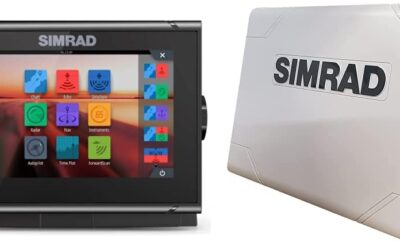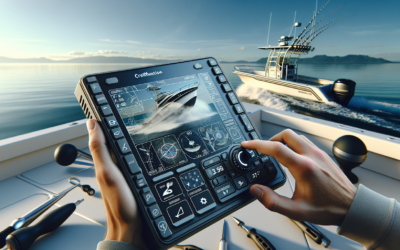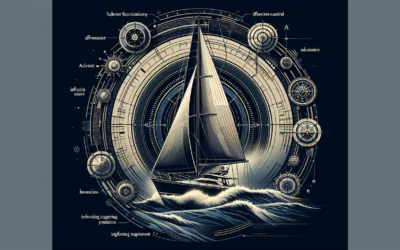Are you a beginner angler who wants to take your fishing game to the next level? Look no further than “Decoding Fish Finders: A Beginner’s Walkthrough.” This comprehensive guide is designed to help you understand the ins and outs of fish finders and how to use them effectively. From deciphering sonar readings to interpreting depth contours, this product will give you the confidence to navigate the world of fish finders like a pro. Don’t miss out on this must-have tool that will revolutionize your fishing experience.
1. Understanding the Basics
1.1 What is a Fish Finder?
A fish finder is a electronic device used by anglers to locate and track fish underwater. It uses sonar technology to detect and display information about the underwater environment, including the presence and location of fish. By providing real-time data, fish finders help fishermen make informed decisions and increase their chances of a successful catch.
1.2 How Does a Fish Finder Work?
Fish finders work by emitting sound waves, or sonar signals, into the water. These sound waves travel through the water and bounce off objects, such as fish or the bottom of the water body. The fish finder then receives the echoes created by the bouncing sound waves and uses them to create a visual representation of the underwater environment on its display. This representation may include information about the depth, composition, and movement of the objects or fish detected.
1.3 Different Types of Fish Finders
There are several types of fish finders available on the market, each with its own set of features and capabilities. The most common types include standalone fish finders, combination fish finders, and castable fish finders.
Standalone fish finders, as the name suggests, are independent units dedicated solely to fish finding. They typically offer a variety of display options and sonar technologies.
Combination fish finders combine fish finding capabilities with other features, such as GPS navigation or chartplotting. These versatile devices offer anglers a comprehensive tool for both finding fish and navigating their way through the water.
Castable fish finders are compact and portable devices that can be cast out into the water using a fishing rod. They are often used in situations where a traditional fish finder cannot be installed, such as from a kayak or shore fishing.
1.4 Importance of Using a Fish Finder
Using a fish finder can greatly enhance your fishing experience and improve your chances of a successful catch. By providing real-time information about fish location and underwater structure, fish finders allow you to make more informed decisions about where to cast your line. This can save you time and frustration, as you can focus your efforts on areas likely to yield results. Additionally, being able to see the depth and temperature of the water can help you understand the behavior of the fish and adjust your fishing techniques accordingly. Overall, a fish finder is a valuable tool that can greatly enhance your fishing skills and increase your chances of having a productive day on the water.
2. Components of a Fish Finder
2.1 Display Unit
The display unit is the part of the fish finder that shows the information gathered by the device. It can vary in size and quality, with larger screens generally being easier to read. The display unit may also have adjustable brightness and color settings to ensure optimal visibility in different lighting conditions. Some advanced fish finders even offer touchscreen displays for easier navigation and control.
2.2 Transducer
The transducer is a critical component of the fish finder, responsible for sending and receiving the sonar signals. It is typically mounted on the hull or transom of the boat, or attached to the fishing line in the case of castable fish finders. The transducer emits the sound waves into the water and captures the returning echoes, which are then sent to the display unit for processing. Transducers come in different shapes and sizes, each designed for specific types of fishing and water conditions.
2.3 GPS Module
Many fish finders are equipped with a GPS module, which allows for precise navigation and tracking. The GPS module can display your current position on a map, mark waypoints, and even provide routing instructions to help you navigate the water. Having GPS capabilities integrated into your fish finder can be especially useful when fishing in unfamiliar waters or trying to locate specific fishing spots.
2.4 Power Source
Fish finders require a power source to operate. Most fish finders can be powered by the boat’s battery or a separate portable power supply. The power source should have sufficient capacity to sustain the fish finder’s operation throughout your fishing trip. It is also important to ensure a reliable power connection to avoid any interruptions or sudden loss of power.
2.5 Mounting and Installation
Proper mounting and installation of the fish finder are essential for optimal performance. Depending on the type of fish finder, it may need to be mounted on the boat’s hull or transom, or be simply cast into the water. Follow the manufacturer’s instructions for installation, taking into consideration factors such as transducer placement and cable routing. Proper installation will ensure accurate readings and prevent any damage to the fish finder.
3. Choosing the Right Fish Finder
3.1 Consideration Factors
When choosing a fish finder, there are several factors you should consider to ensure you select the right device for your fishing needs. These factors include your budget, the type of fishing you plan to do, the size of the water body you typically fish in, and the features you prioritize. By evaluating these factors, you can narrow down your options and find a fish finder that suits your specific requirements.
3.2 Budget
Your budget will play a significant role in determining the type and quality of fish finder you can afford. Fish finders range in price, with basic models being more affordable while advanced models with additional features may be more expensive. It is important to balance your budget with the features and performance you desire to find the best fish finder within your price range.
3.3 Transducer Frequency
Transducer frequency is an important consideration as it determines the depth and clarity of the sonar readings. Fish finders typically operate at frequencies of 50 kHz, 83 kHz, and 200 kHz. Lower frequencies, such as 50 kHz, are better suited for deep water fishing as they provide better depth penetration, while higher frequencies, such as 200 kHz, offer more detail and resolution in shallower waters. Some fish finders also feature multiple frequency options to provide the best of both worlds.
3.4 Screen Resolution and Size
The screen resolution and size of your fish finder’s display unit will impact how well you can read and interpret the information presented. Higher resolution screens offer sharper and more detailed images, making it easier to identify fish and underwater structures. Larger screens provide a larger viewing area, which can be beneficial for anglers who prefer a more comprehensive display. Choose a screen size and resolution that suits your preference and improves your fishing experience.
3.5 GPS and Mapping Features
If navigation and finding specific fishing spots are important to you, consider a fish finder with built-in GPS and mapping capabilities. These features allow you to mark waypoints, create routes, and view detailed maps of the water body. GPS and mapping features can be particularly useful when exploring new fishing locations or navigating through complex water systems. Keep in mind that fish finders with GPS and mapping capabilities often come at a higher price point.
4. Interpreting Fish Finder Readings
4.1 Understanding Sonar Signals
To effectively interpret fish finder readings, it is important to understand the basics of sonar signals. Sonar signals are emitted as a series of pulses, which travel through the water and bounce off objects. The time it takes for the echoes to return to the fish finder is used to determine the distance of the object from the transducer. The intensity of the returned echoes is represented on the display, with stronger echoes indicating denser objects, such as fish or rocks.
4.2 Identifying Fish Arches
Fish arches are a common representation of fish on a fish finder display. They appear as curved lines and are formed when a fish swims through the sonar beam. The top of the arch corresponds to the initial detection of the fish, while the bottom represents its continued movement through the sonar beam. It is important to note that fish arches may not always be present, and different factors such as fish species, water depth, and sonar settings can affect their appearance.
4.3 Differentiating Fish from Debris
Fish finders can also display other objects, such as debris or vegetation, which may be mistaken for fish. One way to differentiate between fish and debris is by analyzing the shape and movement of the objects. Fish typically appear as distinct and individual targets on the display, with a consistent movement pattern. Debris, on the other hand, tends to be less defined and may display erratic movement or no movement at all. By observing these characteristics, you can increase your accuracy in identifying fish.
4.4 Depth and Water Temperature
Fish finders provide valuable information about the depth and water temperature, which can be crucial in understanding fish behavior. The depth reading informs you of the depth at which the fish are located, helping you adjust your fishing techniques accordingly. Additionally, changes in water temperature can affect fish activity and feeding patterns. By monitoring the water temperature, you can identify favorable conditions and increase your chances of finding active fish.
5. Utilizing Advanced Features
5.1 Zoom Function
Many fish finders offer a zoom function, which enables you to focus on a specific area of the water column. With the zoom function, you can magnify a specific depth range, allowing for a closer examination of fish or structure within that range. This can be particularly useful when targeting fish at a specific depth or when trying to identify smaller fish that may not be easily visible on a broader view.
5.2 Split Screen Display
Some fish finders feature a split screen display, which allows you to view multiple sonar views simultaneously. This feature can be beneficial when you want to compare different sonar technologies or view different areas of the water column side by side. By utilizing the split screen display, you can gather more information at a glance and make more informed decisions about your fishing strategies.
5.3 Side Imaging and Down Imaging
Side imaging and down imaging are advanced sonar technologies that provide a more detailed and comprehensive view of the underwater environment. Side imaging uses a wider sonar beam to scan the water on each side of the boat, creating detailed images of underwater structures and fish. Down imaging, on the other hand, directs the sonar beam straight down, offering a clearer view of the bottom and objects directly beneath the boat. These imaging technologies can greatly enhance your ability to locate fish and identify productive fishing areas.
5.4 GPS Mapping Integration
Fish finders with GPS mapping integration offer the ability to overlay sonar readings on top of detailed maps of the water body. This integration allows you to easily identify underwater structures, such as drop-offs, submerged vegetation, or rocky areas, and correlate them with fish activity. By utilizing GPS mapping integration, you can create a comprehensive picture of the underwater environment and plan your fishing strategies more effectively.
6. Tips for Using a Fish Finder
6.1 Adjusting Sensitivity and Gain
When using a fish finder, it is important to adjust the sensitivity and gain settings to optimize the device’s performance. The sensitivity setting controls the strength at which the fish finder detects echoes, while the gain setting adjusts the amplification of the returning signals. By experimenting with these settings, you can fine-tune the fish finder to provide accurate and clear readings based on specific water conditions and fishing objectives.
6.2 Paying Attention to Bottom Conditions
Monitoring the bottom conditions shown on the fish finder display can provide valuable insights into fish behavior. Pay attention to the composition of the bottom, such as sandy areas or rocky structures, as different fish species may prefer different habitats. Tracking changes in the bottom contour throughout your fishing trip can also indicate potential feeding areas or areas where fish are likely to congregate.
6.3 Using Fish Alarms
Many fish finders offer fish alarms that can be set to notify you when fish are detected. These alarms are especially useful when fishing in open water or concentrating on other tasks, as they alert you to potential fishing opportunities. By setting the fish alarms at the desired sensitivity and target size, you can ensure that you are promptly alerted to the presence of fish and increase your chances of making a catch.
6.4 Regular Maintenance
To ensure the optimum performance of your fish finder, regular maintenance is necessary. Clean the display screen with a soft, lint-free cloth to remove any smudges or debris. Check the transducer for any accumulated dirt or obstructions, and clean it if necessary. Inspect the cables and connectors for signs of wear or damage, and replace them if needed. By performing regular maintenance, you can prolong the lifespan of your fish finder and ensure its accurate and reliable operation.

7. Troubleshooting Common Issues
7.1 Interference and Noise
Interference and noise can sometimes affect the performance of fish finders, resulting in distorted or inaccurate readings. One common cause of interference is electromagnetic interference (EMI) from other electronic devices on the boat. To minimize interference, keep the fish finder’s power cables and transducer cables separate from other electronic cables. Additionally, adjusting the sensitivity and gain settings can help reduce noise and improve the clarity of the sonar readings.
7.2 False Readings
False readings can occur when the fish finder detects echoes from non-fish objects, such as air bubbles, debris, or suspended sediment. To minimize false readings, experiment with the sensitivity and gain settings to find the optimal balance. Adjusting the fish finder’s depth range can also help eliminate false echoes from objects outside the desired range.
7.3 Inaccurate Depth Readings
Inaccurate depth readings can be caused by factors such as transducer misalignment or turbulence in the water. Ensure that the transducer is properly installed and aligned according to the manufacturer’s instructions. If turbulent water is affecting the sonar signal, try adjusting the transducer’s depth setting or changing the boat’s speed to minimize turbulence.
7.4 Transducer Placement Issues
Improper transducer placement can result in suboptimal performance or inaccurate readings. Ensure that the transducer is mounted securely and positioned correctly according to the manufacturer’s recommendations. Pay attention to factors such as the transducer’s depth and angle, as well as any obstructions or interference that may affect its performance. Proper transducer placement is essential for accurate readings and reliable fish finding capabilities.
8. Fish Finder Accessories
8.1 Transducer Mounts
Transducer mounts are accessories that help secure the transducer to the boat’s hull or transom. They provide stability and ensure proper alignment, which is crucial for optimal sonar performance. There are various types of transducer mounts available, including adjustable mounts and through-hull mounts. Choose a mount that is compatible with your transducer and boat type for secure and reliable installation.
8.2 Sun Covers
Sun covers, also known as sun shades or screen protectors, are accessories designed to protect the fish finder’s display unit from direct sunlight. Sunlight can cause glare and make it difficult to read the display, especially in bright conditions. Sun covers are typically made of a material that reduces glare and shields the display from harmful UV rays. Using a sun cover can greatly improve visibility and enhance your overall fishing experience.
8.3 Carry Cases
Carry cases provide a convenient and protective solution for transporting and storing your fish finder. These cases are designed to securely hold the fish finder and its accessories, providing cushioning and protection against impact and environmental elements. Look for carry cases that offer padded compartments, adjustable straps, and durable construction to keep your fish finder safe during travel or when not in use.
8.4 Spare Batteries
Having spare batteries on hand is essential for uninterrupted fish finder operation. Fish finders rely on power to function, and a depleted battery can quickly bring your fishing trip to a halt. Carry spare batteries, or consider investing in a portable power supply or battery charger to ensure you have sufficient power for extended fishing excursions.
8.5 Portable Fish Finder Kits
Portable fish finder kits are all-in-one solutions that include a compact fish finder unit, a transducer, and necessary accessories. These kits are ideal for anglers who frequently fish from various locations or who prefer a portable setup. Portable fish finder kits offer convenience and versatility, allowing you to take your fish finder on different fishing adventures without the need for extensive installation or equipment.
9. Safety Considerations
9.1 Following Local Fishing Regulations
When using a fish finder, it is important to follow local fishing regulations and guidelines. Familiarize yourself with any restrictions or special rules that may apply to the water body you are fishing in. Some areas may have specific regulations regarding fish size limits, bag limits, or protected species. By adhering to these regulations, you not only ensure a sustainable fishery but also avoid potential legal consequences.
9.2 Using Secure Mounting Systems
Properly securing your fish finder’s mounting system is essential for safety. Ensure that the mounting brackets, screws, and other fasteners are tightened securely to prevent any accidental detachment while out on the water. Regularly check the mounting system for signs of wear or damage and replace any compromised components to maintain a secure and stable setup.
9.3 Avoiding Navigation Hazards
While fish finders can provide valuable information about the underwater environment, it is important to exercise caution and avoid navigation hazards. Although fish finders can help identify submerged structures, shallow areas, or other obstacles, they may not detect all hazards. Always remain vigilant and use additional navigation tools, such as charts or GPS, to ensure safe navigation and prevent accidents.
10. Frequently Asked Questions
10.1 How far can a fish finder detect fish?
The range at which a fish finder can detect fish varies depending on several factors, including the power and frequency of the sonar, water conditions, and the size of the fish. In general, fish finders can detect fish within a range of a few feet to several hundred feet, depending on these factors. However, it is important to note that fish finders are not capable of detecting fish in all conditions, such as when fish are hiding under dense vegetation or in extremely murky water.
10.2 Can fish finders work in saltwater?
Yes, fish finders can work in saltwater environments. However, it is important to choose a fish finder that is specifically designed for saltwater use. Saltwater fish finders are built with corrosion-resistant materials and have features that can withstand the harsh conditions of saltwater fishing, such as stronger transducers and waterproof construction. Be sure to select a fish finder that is specifically rated for saltwater use to ensure its durability and longevity.
10.3 Can fish finders be used for ice fishing?
Yes, fish finders can be used for ice fishing. Ice fishing fish finders are typically smaller, portable units that are designed to be used in cold weather conditions. They feature special features such as ice mode, which optimizes the sonar readings for ice fishing. Additionally, ice fishing fish finders often have built-in thermometers to measure the ice thickness and water temperature. These features can greatly assist ice anglers in locating fish and identifying productive fishing spots.
10.4 How to maintain and clean a fish finder?
To maintain and clean a fish finder, follow these simple steps:
- Wipe the display screen with a soft, lint-free cloth to remove any smudges or debris.
- Clean the transducer with fresh water to remove any accumulated dirt or algae.
- Check the cables and connectors for any signs of wear or damage. Replace them if necessary.
- Inspect the mounting brackets and screws, ensuring they are securely fastened.
- If your fish finder is equipped with a GPS module, periodically update the software to ensure accurate navigation.
- Store your fish finder in a cool and dry place when not in use, and protect it from extreme temperatures and direct sunlight.
- Regularly check for any software updates or firmware upgrades provided by the manufacturer and install them as needed. These updates can improve the performance and functionality of your fish finder.
By following these maintenance and cleaning practices, you can ensure that your fish finder remains in optimal condition and provides accurate and reliable readings.











